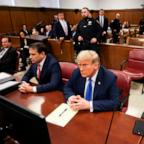Can CP3, Clippers continue to play so well without Blake Griffin?
— -- Another postseason, another untimely injury for the LA Clippers. Forward Blake Griffin left Friday's Game 3 win over the Utah Jazz with what was described as a bruised right toe and didn't return. On Saturday morning, the real diagnosis was revealed: a plantar plate injury that will sideline Griffin for the remainder of the playoffs.
A year after being eliminated in the first round when both Griffin and Chris Paul were lost to series-ending injuries during Game 4 against the Portland Trail Blazers, the Clippers have to be feeling a sense of d?j? vu.
This postseason is different, however, because the Clippers still have Paul and have succeeded without Griffin before. How far can they go without him this time around?
Clippers without Griffin
At the time Griffin landed awkwardly on a drive in transition and suffered the toe injury, the Clippers were completing an 11-2 run but still trailed the host Jazz by four. They outscored Utah by nine the rest of the way to secure the win, which put them in command of the series, up 2-1.
That second half featured a virtuoso performance by Paul (10 assists and 34 points, 24?after halftime). The win was a reminder of how effective the Clippers have been when they play small and spread the court anytime Griffin is absent for an extended period.
This season, Griffin's absence, after knee surgery in December, was complicated by concurrent injuries that Paul suffered. The Clippers' All-Star point guard also missed seven games during that span with a hamstring strain and then sprained his thumb not long before Griffin's return, an injury that kept Paul out through the All-Star break.
The Clippers went 3-7 in the 10 games they played with neither of their top two players, and went 5-6 when Griffin played and Paul did not; they also lost a game when both Griffin and All-Star center DeAndre Jordan rested due to a back-to-back. But in the 10 games they played with Paul and Jordan but not Griffin, they went 8-2 with a slightly better point differential adjusted for opponent quality and location than in games when both Paul and Griffin played.
This isn't new. The Clippers have consistently stayed afloat during Griffin's injuries, going 30-15 without him during an extended absence in 2015-16 and 9-6 in 2014-15. They tend to adjust, with Paul looking to create more of his offense rather than serving primarily as a distributor, while Jordan takes advantage of the improved spacing to dominate the paint.
What we haven't seen yet is the Clippers try to win with this style in the playoffs. Because Paul was injured earlier in Game 4 last year, they never got the chance. And despite Griffin's injury history, he had never previously missed time during the postseason, though he was limited by a sprained right ankle during a 2013 first-round loss to the Memphis Grizzlies.
Impact of Griffin's latest injury
Griffin's absence might be felt more keenly during the playoffs for a few reasons. First, it takes away the possibility of Clippers coach Doc Rivers staggering his two stars, something he's been reluctant to do in the past but had done early in this series. Playing either Griffin or Paul with reserves should give LA a better chance of creating efficient offense, limiting what has been the Clippers' biggest weakness in the postseason -- seeing leads dwindle or deficits grow with the second unit on the court.
We've also yet to see how defenses might adjust to the Clippers' smaller lineups without Griffin given extra time to prepare. While the Jazz had no answers for Paul in the pick-and-roll game during Game 3, they might try something different now that they know Griffin isn't involved going into the game.
According to NBA.com/Stats, Paul made all four field goals the Clippers scored during the final five minutes of Friday's game, and he attempted six of their seven shots. (Jordan also went to the free throw line before Utah started intentionally fouling.) Given Paul's dominance of the ball, the Jazz might consider trapping him on pick-and-rolls and forcing another Clipper to make a play now that Griffin isn't an option.
The last issue for the Clippers going forward is depth. When Griffin was out during the regular season, Rivers relied heavily on his son Austin, who has been sidelined since March 29 with a hamstring strain. Down two starters, the Clippers are going deep into their thin bench.
Rivers played 39-year-old Paul Pierce 18 minutes after halftime on Friday, more than Pierce played in all but two games during the regular season. And with backup center Marreese Speights sliding over to power forward to give Pierce a break, Jordan checked out of the game only when the Jazz were intentionally fouling. That type of playing time isn't sustainable for either player.
Until Austin returns, Doc will probably have to go to little-used backup forward Wesley Johnson, who's been unable to win his coach's trust despite the team playing well with him on the court this season.
Outlook for the Clippers
With home-court advantage back in their hands and Utah dealing with its own injured starter (center Rudy Gobert), the Clippers should be comfortably favored to win this series without Griffin, unless Gobert can return soon.
Griffin's injury figures to be more of an issue if the Clippers advance and face the Golden State Warriors, who lead their first-round series with the Portland Trail Blazers 2-0. The Warriors have been unbeatable for the Clippers the past two seasons no matter the circumstances, winning 10 consecutive matchups.
To break Golden State's streak, the Clippers surely would need both Griffin and Paul playing at a high level. The Warriors have the talent and the depth to exploit more limited Clippers lineups. While the Clippers?were overwhelming underdogs in a possible second-round matchup anyway, they would have an even more difficult time pulling the upset without Griffin.




